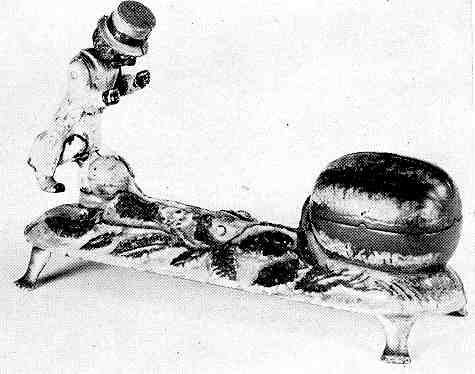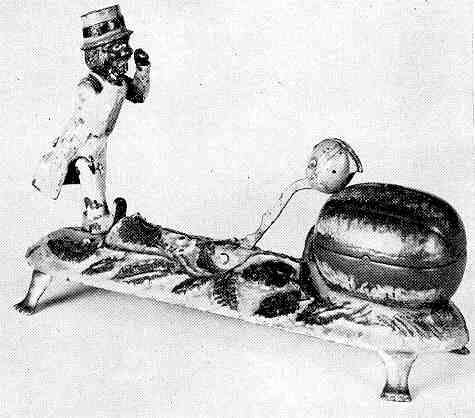Football Bank (Darky and Watermelon)
by F.H. Griffith - HOBBIES Magazine - April, 1969

Some years ago the classification article covering the Football Bank
(Darky and Watermelon) appeared in HOBBIES. This was the April 1954 issue and the writer
had not actually seen the bank or had the opportunity to examine it personally and so on.
Circumstances at the time did not permit his so doing, which is an unusual, exceptional
case.
In any event, we are very pleased to say that Mr. W.W. Tudor of Chicago, Illinois,
recently ac-quired a fine example of the Football pictured herewith. The writer through
the courtesy of Mr. Tu-dor has examined this bank carefully and thoroughly. On close
scrutiny of this important bank a number of features not covered in the original
classification article came to light. Therefore, we are now able to go into thorough
accurate detail on the Football and also picture it before and after the excellent action.
The bank shown turned up in the New England area and Mr. Tudor acquired it for his rapidly
increasing collection shortly before New Year's 1969.
The Football was designed and then patented by Charles A. Bailey, June 26, 1888, and it
ranks as one of his top mechanicals showing his fine design work, great action, and clever
subject matter. The bank as produced commercially closely follows the patent and drawings
with a refinement or two. This has to do with the base standing on four legs or feet (like
some other Bailey banks), and the addition of a lever under the base which lifts the
football slightly just before the foot of the fig-ure kicks it. More about this further
on.

The Football Bank pictured is in extra fine original paint condition. Gold
feet or legs support the overall gray base which has large green leaves and yellow flowers
thereon. The sizeable water-melon is green with lighter green definition giving it a
realistic appearance. The football and the lever holding same are tan. The hat and shoes
of the figure are the same tan as the football, and the hat has a black band. He wears a
long blue coat with white shirt, red vest and yellow trousers. The face of the figure has
red lips, white teeth, and white eyes with black pupils. This completes the col-oring of a
very attractive bank.
To operate the bank the right leg of the figure is first pulled back into position as
shown in Fig-ure 1. In so doing his arms and head automatically lower into the positions
as shown (Figure 1). The football, fastened to a lever or arm, is then moved into position
as also shown in Figure 1. A coin is placed in the provided slot in the football and the
operating lever in the coat tails of the figure is then pressed. This releases the kicking
right leg and foot, engaging the football and propelling it in an arc to the watermelon as
shown in Figure 2. The coin drops from the football into the provided slot in the
watermelon which is the coin container. As this action takes place the arms and head of
the figure move upward to the positions as shown in Figure 2. The action is quite
realistic and most attractive.
An explanation of certain mechanical features are of importance. For one, there is a brass
lever under the base, one end of which engages the underside of the lever fastened to the
football, and the other end protrudes through a slot in the base between the kicking leg
and the football when posi-tioned for kicking. As the foot moves forward to kick the
football it first strikes this brass lever pushing it down, which in turn causes the
football to lift just before the foot strikes it. This initial momentum relieves the shock
of impact and possible snapping of the football from its holding lever. Another mechanical
feature has to do with the arms and head of the figure. The arms are con-nected inside to
the kicking leg. As the leg kicks forward the arms are caused to move upward. The movable
head is free and not connected to the arms, however, the left hand as it moves into
position engages the left cheek of the face pushing the head back and momentum plus
balance then cause it to assume the position as in Figure 2. Then as the right leg is
again pulled back for operation the arms lower and a part on the arms inside the figure
gives the head a slight push causing it to drop forward and down (Figure 1). The operating
spring for the right kicking leg goes from the underside of the base up through the leg of
the figure where it is fastened to an offset on the right leg.
For removal of coins - the watermelon is in two halves held together and to the base by a
sin-gle vertically positioned screw. Removing this screw allows separation of the two
halves of the watermelon and removal of the watermelon from the base.
In closing, Mr. Tudor is certainly to be congratulated on his acquisition of this fine
mechanical bank. It is a great find and enhances his collection considerably. The writer
just can't help men-tioning that of the known mechanicals he is looking for, the Football
Bank (Darky and Watermelon) is the one he desires more than any other on his 'Want List'.
This is a tough challenge when, to the best of the writer's knowledge, the last one to
turn up prior to the present one was in the 1940's.
One last point of interest - the same unusual washer-nut single unit as used on the
Milking Cow holds the figure of the Darky, by his left leg, to the base. This cast
washer-nut combination is unique where mechanical banks are concerned and its use on both
banks helps to further confirm the writer's opinion attributing the Milking Cow to Bailey
as expressed in the HOBBIES article August 1953 covering the Milking Cow.
